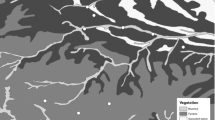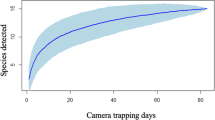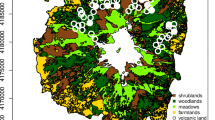Abstract
Migration occurs over a relatively short time period, but can result in an increased likelihood of mortality. Many populations of Southern Mountain Caribou, an Endangered subspecies in Canada, demonstrate altitudinal migration when moving between alpine and subalpine ranges. These caribou can encounter a high density of predators when transiting low- or mid-elevation valleys. We used camera traps to document the movements of caribou as well as moose, a sympatric ungulate that enhances the distribution and abundance of shared predators, through a mid-elevation valley that was characterized by resource roads and forestry clearcuts. The seasonal occurrence of moose coincided with the migratory movements of caribou (June–September). Similarly, the relative abundance of wolves and bears was greatest when caribou occupied the corridor. We used logistic regression to relate camera images to a range of ecological variables that we hypothesized influenced the seasonal distribution and risk of predation for moose and caribou. The most predictive model suggested that the probability of occurrence of caribou increased with temperature, precipitation, and week of the year. A factor for year revealed that the occurrence of caribou declined over the monitoring period. The most parsimonious model for moose included the same covariates as the most predictive model for caribou. A comparison of the frequency of caribou images with those crossings inferred from GPS-collar data revealed that the camera traps were relatively ineffective at monitoring the migratory movements of caribou. This study provided unique insights into the migration of a declining population of caribou, their interactions with predators, and the limitations of using camera traps to document the infrequent movements of low-density species.






Similar content being viewed by others
Data availability
Data available upon request.
References
Apps CD, Kinley T (2000) Mountain caribou habitat use, movements, and factors associated with GPS location bias in the Robson Valley, British Columbia. Report prepared for Columbia Basin Fish and Wildlife Compensation Program, BC, Canada
Apps CD, McLellan B, Kinley T, Flaa J (2001) Scale-Dependent habitat selection by mountain caribou, Columbia Mountains, British Columbia. J Wildlife Manage 65:65–77
Apps CD, Mclellan BN, Kinley TA, Serrouya R, Seip DR, Wittmer HU (2013) Spatial factors related to mortality and population decline of endangered mountain caribou. J Wildlife Manage 77:1409–1419
Ball JP, Nordengren C, Wallin K (2001) Partial migration by large ungulates: characteristics of seasonal moose Alces alces ranges in northern Sweden. Wildlife Biol 7:39–47
Battin J (2004) When good animals love bad habitats: Ecological traps and the conservation of animal populations. Conserv Biol 18:1482–1491
BC Parks (2005) Sugarbowl-Grizzly Den Provincial Park and Protected Area Purpose Statement and Zoning Plan. http://www.env.gov.bc.ca/bcparks/planning/mgmtplns/sugarbowl_grizzly/sugarbowl_grizzly_ps.pdf?v=1577071352691
Berg JE, Hebblewhite M, St. Clair CC, Merrill EH (2019) Prevalence and mechanisms of partial migration in ungulates. Front Ecol Evol 7:325
Bergerud AT (1992) Rareness as an antipredator strategy to reduce predation risk for moose and caribou. In: McCullough DR, Barrett RH (eds) Wildlife 2001: populations. Elsevier Applied Science, London, pp 1008–1021
Bergerud AT, Butler HE, Miller DR (1984) Antipredator tactics of calving caribou: dispersion in mountains. Can J Zool 62:1566–1575
Blanchet FG, Cazelles K, Gravel D (2020) Co-occurrence is not evidence of ecological interactions. Ecol Lett 23:1050–1063
Boyce MS, Vernier PR, Nielsen SE, Schmiegelow FKA (2002) Evaluating resource selection functions. Ecol Model 157:281–300
Boyle WA, Norris RD, Guglielmo CG (2010) Storms drive altitudinal migration in a tropical bird. Proc R Soc B 277:2511–2519
Broadley K, Burton AC, Avgar T, Boutin S (2019) Density-dependent space use affects interpretation of camera trap detection rate. Ecol Evol 9:14031–14041
Burton AC, Neilson E, Moreira D, Ladle A, Steenweg R, Fisher JT, Bayne E, Boutin S (2015) REVIEW: Wildlife camera trapping: a review and recommendations for linking surveys to ecological processes. J Appl Ecol 52:675–685
COSEWIC (2011) Designatable Units for Caribou (Rangifer tarandus) in Canada. Committee on the Status of Endangered Wildlife in Canada. Ottawa. 88 pp. http://www.cosewic.gc.ca/eng/sct12/COSEWIC_Caribou_DU_Report_23Dec2011.pdf. Accessed 1 May 2020
COSEWIC (2014) COSEWIC assessment and status report on the Caribou Rangifer tarandus, Northern Mountain population, Central Mountain population and Southern Mountain population in Canada. Committee on the Status of Endangered Wildlife in Canada, Ottawa. Xxii–113. www.registrelep-sararegistry.gc.ca/default_e.cfm
DeCesare NJ, Hebblewhite M, Bradley M, Hervieux D, Neufeld L, Musiani M (2014) Linking habitat selection and predation risk to spatial variation in survival. J Anim Ecol 83:343–352
Dickie M, Serrouya R, McNay RS, Boutin S (2017) Faster and farther: wolf movement on linear features and implications for hunting behaviour. J Appl Ecol 54:253–263
Dyer SJ, O’Neill JP, Wasel SM, Boutin S (2001) Avoidance of industrial development by woodland caribou. J Wildlife Manage 65:531–542
Ehlers LPW, Johnson CJ, Seip DR (2016) Evaluating the influence of anthropogenic landscape change on wolf distribution: implications for woodland caribou. Ecosphere 7:e01600
ESRI (2011) ArcGIS Desktop: Release 10. Environmental Systems Research Institute, Redlands, CA
Faille G, Dussault C, Ouellet J-P, Fortin D, Courtois R, St-Laurent M-H, Dussault C (2010) Range fidelity: The missing link between caribou decline and habitat alteration? Biol Conserv 143:2840–2850
Fielding AH, Bell JF (1997) A review of methods for the assessment of prediction errors in conservation presence/absence models. Environ Conserv 24:38–49
Government of BC (2018) Provincial Caribou Recovery Program—Discussion Paper. Ministry of Forests, Lands and Natural Resources Operations and Rural Development. https://engage.gov.bc.ca/app/uploads/sites/373/2018/04/Provincial-Caribou-Recovery-Program-Apr18_Rev.pdf Accessed 8 June 2020
Gurarie E, Hebblewhite M, Joly K, Kelly AP, Adamczewski J, Davidson SC, Davison T, Gunn A, Suitor MJ, Fagan WF, Boelman N (2019) Tactical departures and strategic arrivals: Divergent effects of climate and weather on caribou spring migrations. Ecosphere 10:e02971
Gustine DD, Parker KL, Lay RJ, Gillingham MP, Heard DC (2006) Calf survival of woodland caribou in a multi-predator ecosystem. Wildlife Monogr 165:1–32
Harris G, Thirgood S, Hopcraft JGC, Cromsigt JPGM, Berger J (2009) Global decline in aggregated migrations of large terrestrial mammals. Endanger Species Res 7:55–76
Hebblewhite M, White CA, Nietvelt CG, McKenzie JA, Hurd TE, Fryxell JM, Bayley SE, Paquet PC (2005) Human activity mediates a trophic cascade caused by wolves. Ecology 86:2135–2144
Hobbs KA, Wassenaar LI (eds) (2019) Tracking animal migration with stable isotopes. Academic Press, London
Holinda D, Burgar JM, Burton AC (2020) Effects of scent lure on camera trap detections vary across mammalian predator and prey species. PLoS ONE 15(5):e0229055
James ARC, Boutin S, Hebert D, Rippin A (2004) Spatial separation of caribou from moose and its relation to predation by wolves. J Wildlife Manage 68:799–809
Johnson CJ, Parker KL, Heard DC, Gillingham MP (2002a) Movement parameters of ungulates and scale-specific responses to the environment. J Anim Ecol 71:225–235
Johnson CJ, Parker KL, Heard DC, Gillingham MP (2002b) A multiscale behavioural approach to understanding the movements of woodland caribou. Ecol Appl 12:1840–1860
Johnson CJ, Seip DR, Boyce MS (2004) A quantitative approach to conservation planning: Using resource selection functions to map the distribution of mountain caribou at multiple spatial scales. J Appl Ecol 41:238–251
Johnson CJ, Ehlers LPW, Seip DR (2015) Witnessing extinction—cumulative impacts across landscapes and the future loss of an evolutionarily significant unit of woodland caribou in Canada. Biol Conserv 186:176–186
Johnson CJ, Mumma MA, St-Laurent M-H (2019) Modelling multispecies predator-prey dynamics: predicting the outcomes of conservation actions for woodland caribou. Ecosphere 10:e02622
Klaczek M, Heard D (2016) Population assessment of Southern Mountain Caribou (Rangifer tarandus) in the Prince George Forest District. FLNRORD, vi–17 (https://www2.gov.bc.ca/assets/gov/environment/plants-animals-and-ecosystems/wildlife-wildlife-habitat/caribou/population_assessment_of_southern_mountain_caribou_in_the_prince_george_forest_district_-_2016.pdf)
Klaczek M, Lirette D (2018) 2018 Mountain Caribou Census in the North Cariboo Mountains and narrow lake ranges. Ministry of Forests, Lands and Natural Resource Operations, Prince George, BC
Kolowski JM, Forrester TD (2017) Camera trap placement and the potential for bias due to trails and other features. PLoS ONE 12:e0186679
LeResche RE (1974) Moose migrations in North America. Nat Can 101:393–415
Lesmerises F, Déry F, Johnson CJ, St-Laurent M-H (2018) Spatiotemporal response of mountain caribou to the intensity of backcountry skiing. Biol Conserv 217:149–156
Mahoney SP, Lewis K, Weir J, Morrison S, Luther G, Schaefer JA, Pouliot DA, Latifovic R (2016) Woodland caribou calf mortality in Newfoundland: insights into the role of climate, predation and population density over three decades of study. Pop Ecol 58:91–103
Manel S, Williams HC, Ormerod SJ (2001) Evaluating presence-absence models in ecology: the need to account for prevalence. J Appl Ecol 38:921–931
Meidinger D, Pojar J, Harper WL (2019) Biogeoclimatic Ecosystem Classification Program. BC Forest Service Research Branch. https://www.for.gov.bc.ca/hre/becweb/program/index.html. Accessed 15 May 2020
Merkle JA, Monteith KL, Aikens EO, Hayes MM, Hersey KR, Middleton AD, Oates BA, Sawyer H, Scurlock BM, Kauffman MJ (2016) Large herbivores surf waves of green-up during spring. Proc R Soc B 283:20160456
Middleton AD, Kauffman MJ, McWhirter DE, Cook JG, Cook RC, Nelson AA, Jimenez MD, Klaver RW (2013) Animal migration amid shifting patterns of phenology and predation: lessons from Yellowstone. Ecology 94:1245–1256
Mumma MA, Gillingham MP, Johnson CJ, Parker KL (2017) Understanding predation risk and individual variation in risk avoidance for threatened boreal caribou. Ecol Evol 7:10266–10277
Mumma MA, Gillingham MP, Parker KL, Johnson CJ, Watters M (2018) Predation risk for boreal woodland caribou in human-modified landscapes: Evidence of wolf spatial responses independent of apparent competition. Biol Conserv 228:215–223
Mysterud A (2013) Ungulate migration, plant phenology, and large carnivores: the times they are a-changin’. Ecology 94:1257–1261
Newkirk ES (2016) CPW Photo Warehouse. Colorado Parks and Wildlife, Fort Collins, CO, USA. http://cpw.state.co.us/learn/Pages/ResearchMammalsSoftware.aspx
O’Connor KM, Nathan LR, Liberati MR, Tingley MW, Vokoun JC, Rittenhouse TAG (2017) Camera trap arrays improve detection probability of wildlife: Investigating study design considerations using an empirical dataset. PLoS ONE 12:e0175684
Pinard V, Dussault C, Ouellet JP, Fortin D, Courtois R (2012) Calving rate, calf survival rate and habitat selection of forest-dwelling caribou in a highly managed landscape. J Wild Manage 76:189–199
Polfus JL, Hebblewhite M, Heinemeyer K (2011) Identifying indirect habitat loss and avoidance of human infrastructure by northern mountain woodland caribou. Biol Conserv 144:2637–2646
Poole KG, Stuart-Smith K (2005) Fine-scale winter habitat selection by moose in interior montane forests. Alces 41:1–8
Poole KG, Heard DC, Mowat G (2000) Habitat use by woodland caribou near Takla Lake in central British Columbia. Can J Zool 78:1552–1561
Pullinger MG, Johnson CJ (2010) Maintaining or restoring connectivity of modified landscapes: evaluating the least-cost path model with multiple sources of ecological information. Landscape Ecol 25:1547–1560
Ray JC, Cichowski DB, St-Laurent M-H, Johnson CJ, Petersen SD, Thompson ID (2014) Conservation status of caribou in the western mountains of Canada: Protections under the Species at Risk Act, 2002–2014. Rangifer 35:46–80
Rettie WJ, Messier F (2000) Hierarchical habitat selection by woodland caribou: its relationship to limiting factors. Ecography 23:466–478
Ripple WJ, Beschta RL (2003) Wolf reintroduction, predation risk, and cottonwood recovery in Yellowstone National Park. For Ecol Manag 184:299–313
Rolandsen CM, Solberg EJ, Sæther B-E, Moorter BV, Herfindal I, Bjørneraas K (2017) On fitness and partial migration in a large herbivore – migratory moose have higher reproductive performance than residents. Oikos 126:547–555
Rovero F, Zimmermann F, Berzi D, Meek P (2013) “Which camera trap type and how many do I need?” A review of camera features and study designs for a range of wildlife research applications. Hystrix 24:148–156
Santomauro D, Johnson CJ, Fondahl G (2012) Historical-ecological evaluation of long-term distribution of woodland caribou and moose in central British Columbia. Ecosphere 3:37
Seip D (1990) Ecology of woodland caribou in Wells Gray Provincial Park. BC Ministry of Environment Wildlife Bulletin No. B-68, Victoria, BC
Seip D (1992) Factors limiting woodland caribou populations and their interrelationships with wolves and moose in southeastern British Columbia. Can J Zool 70:1494–1503
Seip D (2008) Mountain caribou interactions with wolves and moose in central British Columbia. Alces 44:1–5
Seip D, Heard D, Watts G (2011) Mountain caribou census in the North Cariboo Mountains and Narrow Lake. B.C. Ministry of Environment, Prince George, BC
Serrouya R, McLellan BN, Boutin S, Seip DR, Nielsen SE (2011) Developing a population target for an overabundant ungulate for ecosystem restoration. J Appl Ecol 48:935–942
Serrouya R, McLellan B, Oort H, Mowat G, Boutin S (2017) Experimental moose reduction lowers wolf density and stops decline of endangered caribou. PeerJ 5:e3736
Serrouya R, Seip DR, Hervieux D, McLellan BN, McNay RS, Steenweg R, Heard DC, Hebblewhite M, Gillingham M, Boutin S (2019) Saving endangered species using adaptive management. Proc Natl Acad Sci USA 116:6181–6186
Shepard DB, Kuhns AR, Dreslik MJ, Phillips CA (2008) Roads as barriers to animal movement in fragmented landscapes. Anim Conserv 11:288–296
Spitz DB, Hebblewhite M, Stephenson TR (2019) Habitat predicts local prevalence of migratory behaviour in an alpine ungulate. J Anim Ecol 89:1032–1044
StataCorp (2015) Stata Statistical Software: Release 14. StataCorp LP, College Station, TX
Terry EL, McLellan BN, Watts GS (2000) Winter habitat ecology of mountain caribou in relation to forest management. J Appl Ecol 37:589–602
Tucker MA, Böhning-Gaese K, Fagan WF et al (2018) Moving in the Anthropocene: global reductions in terrestrial mammalian movements. Science 359:466–469
Whittington J, Hebblewhite M, DeCesare NJ, Neufeld L, Bradley M, Wilmhurst J, Musiani M (2011) Caribou encounters with wolves increase near roads and trails: a time-to-event approach. J Appl Ecol 48:1535–1542
Williams RL (2000) A note on robust variance estimation for cluster-correlated data. Biometrics 56:645–646
Wittmer HU, Sinclair ARE, McLellan BN (2005) The role of predation in the decline and extirpation of woodland caribou. Oecologia 144:257–267
Wittmer HU, McLellan BN, Hovey FW (2006) Factors influencing variation in site fidelity of woodland caribou (Rangifer tarandus caribou) in southeastern British Columbia. Can J Zool 84:537–535
Wittmer HU, McLellan BN, Serrouya R, Apps CD (2007) Changes in landscape composition influence the decline of a threatened woodland caribou population. J Anim Ecol 76:568–579
Acknowledgements
Staff at BC Parks deserve much thanks for deploying and monitoring cameras over the 6-year study period. Scott Back was instrumental in starting and supporting the project and Andrew Letts played a large role in managing the cameras and associated data. We thank Kate Steeves for her hard work in organizing and classifying images. Roy Rea and three anonymous reviewers provided valuable comments on an earlier version of this manuscript. Mike Klaczek and the Ministry of Forests, Lands, Natural Resource Operations and Rural Development generously provided the GPS-collar data. This research was funded by BC Parks and the Natural Sciences and Engineering Research Council of Canada.
Funding
This research was funded through a grant from the BC Parks Park Enhancement Fund and a Discovery Grant from the Natural Sciences and Engineering Research Council of Canada.
Author information
Authors and Affiliations
Corresponding author
Ethics declarations
Conflict of interest
Neither author has a conflict of interest relative to the findings of this research.
Additional information
Communicated by Karen E. Hodges.
Publisher's Note
Springer Nature remains neutral with regard to jurisdictional claims in published maps and institutional affiliations.
Rights and permissions
About this article
Cite this article
Blagdon, D., Johnson, C.J. Short term, but high risk of predation for endangered mountain caribou during seasonal migration. Biodivers Conserv 30, 719–739 (2021). https://doi.org/10.1007/s10531-021-02114-w
Received:
Revised:
Accepted:
Published:
Issue Date:
DOI: https://doi.org/10.1007/s10531-021-02114-w




